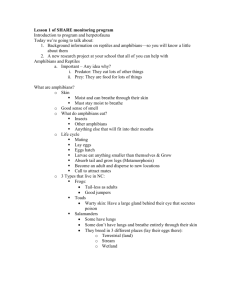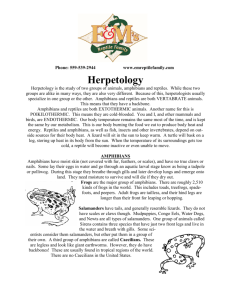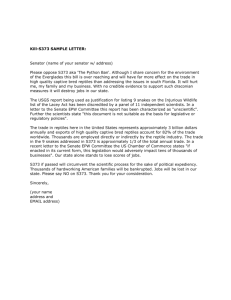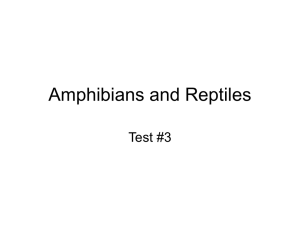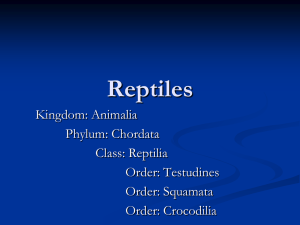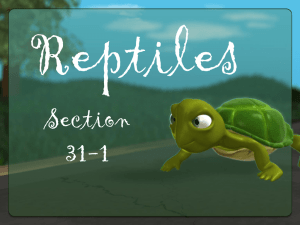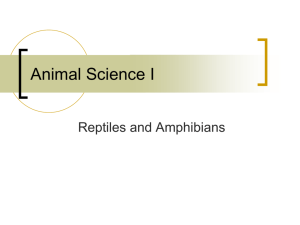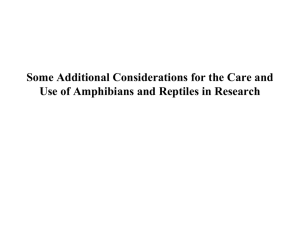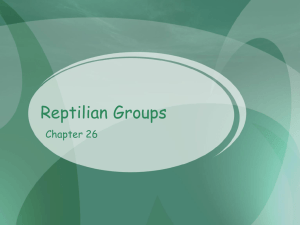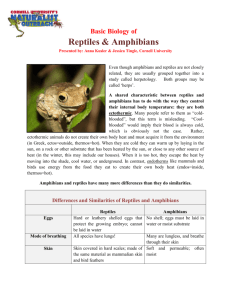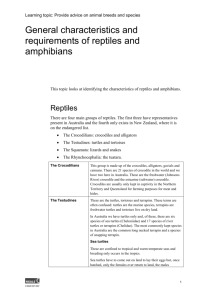High School Lesson
advertisement
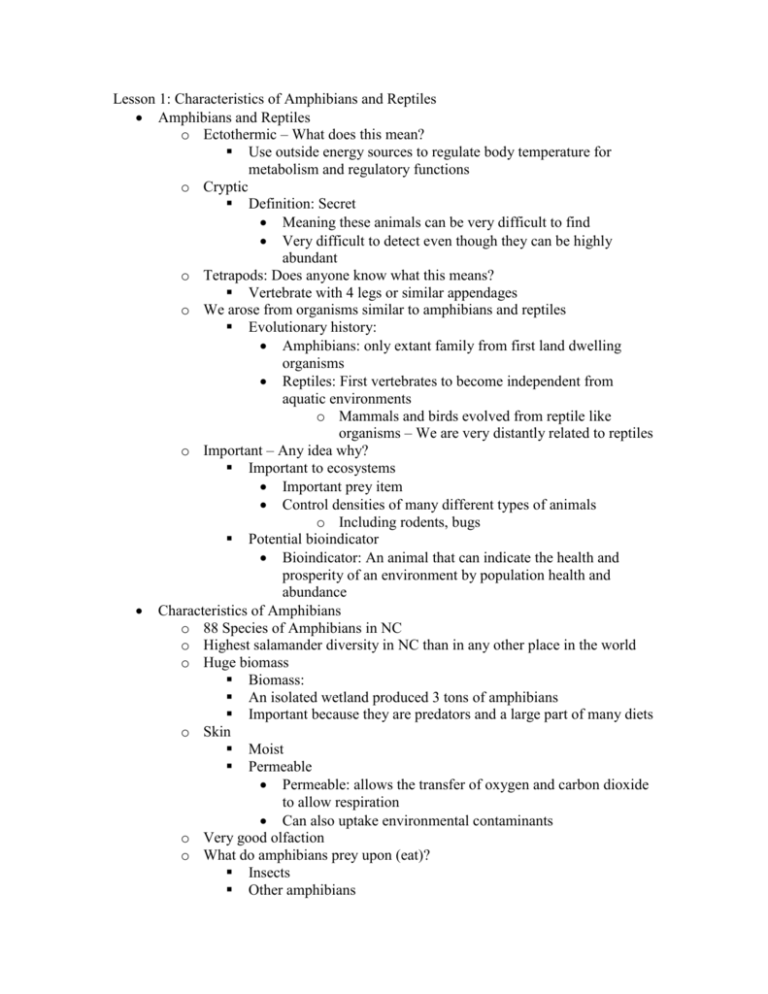
Lesson 1: Characteristics of Amphibians and Reptiles Amphibians and Reptiles o Ectothermic – What does this mean? Use outside energy sources to regulate body temperature for metabolism and regulatory functions o Cryptic Definition: Secret Meaning these animals can be very difficult to find Very difficult to detect even though they can be highly abundant o Tetrapods: Does anyone know what this means? Vertebrate with 4 legs or similar appendages o We arose from organisms similar to amphibians and reptiles Evolutionary history: Amphibians: only extant family from first land dwelling organisms Reptiles: First vertebrates to become independent from aquatic environments o Mammals and birds evolved from reptile like organisms – We are very distantly related to reptiles o Important – Any idea why? Important to ecosystems Important prey item Control densities of many different types of animals o Including rodents, bugs Potential bioindicator Bioindicator: An animal that can indicate the health and prosperity of an environment by population health and abundance Characteristics of Amphibians o 88 Species of Amphibians in NC o Highest salamander diversity in NC than in any other place in the world o Huge biomass Biomass: An isolated wetland produced 3 tons of amphibians Important because they are predators and a large part of many diets o Skin Moist Permeable Permeable: allows the transfer of oxygen and carbon dioxide to allow respiration Can also uptake environmental contaminants o Very good olfaction o What do amphibians prey upon (eat)? Insects Other amphibians Anything else that will fit into their mouths o 4 Types: Frogs: Tail-less as adults True Frogs (Rana)– o All frogs except Tree frogs and allies, and Narrowmouth frog Tree Frogs (Hyla) – Toe pads o Tree frogs Toads Tadpoles lose tail and grow legs as they metamorphose into adults Less dependent on water sources in adult life stages Warty skin o Paratoid gland: Glands behind the eye that secrete toxin Salamanders Plethodons: Lungless, obligate aerobic respiration through their skin Ambystoma: with lungs o Facultative, aerobic respiration through the skin Large salamanders found in large rivers o Hellbenders grow to over 2 feet here, but up to 5 or 6 feet in Japan or China Broken down into three different breeding types o Terrestrial – Never require a water body for reproduction – utilize moisture underneath leaves and logs, also no larval stage o Stream – Adults utilize upland habitats but need stream for breeding, larval period, and occasional foraging o Wetland – Adults live and feed in upland habitats, but breed in wetlands Caecillians Live in the tropics (not in North Carolina) Leg-less and blind Look very similar to a worm o Life cycle Courting Frog Calls Mating Lay eggs Eggs hatch Larvae eat anything smaller than themselves & Grow Metamorphosis Absorb tail and grow legs Become an adult and disperse to new locations o Defense Mechanisms Toxins in skin: Toads and newts Producing large numbers of offspring Producing noisy squawks when attacked REPTILES o Over 70 different species from 4 different groups Groups include: lizards, snakes, turtles, crocodilians o Antarctica the only continent w/o reptiles o Snakes have no legs, but still tetrapods Evolutionary loss of legs Boas still maintain a pelvic girdle o No Gills – First Vertebrates to become free from Aquatic environments Give birth to live young or lay terrestrial eggs w/ leathery shells Some reptiles have reverted back to aquatic environments Sea Snakes Aquatic snakes such as the swamp snake Sea Turtles o Ecothermic: Still maintain a constant temp range Maintained by basking, movement, and shivering Brummation = hibernation o Crocodilians Only species in NC is the American Alligator Osteoderms: Bony scutes: their bones are embedded in their skin making it very tough TSD: Temperature Sex Determination: Sex of offspring is determined by the temperature the eggs are incubated at o Turtles Also have TSD Vertebrae are incorporated into the shell Lack teeth (they have beaks) Omnivorous 3 types of habitats Marine o All threatened or endangered o Leatherback turtle, Green, Hawksbill, Kemp Ridley, ect. Freshwater ponds and wetlands o Snapping Turtle, Painted Turtle, Slider, Mud, Musk, Bog, Cooter, ect Terrestrial o Box Turtles o Squamata Lizards and Snakes Jacobson’s organ Olfactory organ Tongue flicks out of the mouth and moves chemicals in the air to the organ Jawbones extremely movable Lizards Extremely variable and diverse o Many islands have several endemic species o Do you know what endemic means? Only found in one location Do they all have legs? o Legless Glass Lizards Known as Jointed snakes Look like snakes, but they have ear openings, eyelids and are ½ tail They have ears and eyelids (Distinguishing characteristics from snakes) Snakes NC has 37 species of snakes 6 poisonous – Do you know what they are? o Copperhead o Timber Rattlesnake o Diamondback Rattlesnake o Pygmy Rattlesnake o Cottonmouth o Coral Snake Most snakes are non-poisonous All snakes lack legs No ear holes: they hear vibrations through the ground They shed their skin as part of their growth Reproduction o Lay terrestrial eggs o Some are capable of giving birth to live young Feeding o Entirely Carnivorous o Swallow prey whole Can eat animals much bigger than themselves o Some use venom o Some constrict o Either sit and wait predator or active forager Defense Mechanisms o Crypsis :They try to stay camouflaged o When they are detected, they: Flee Musk Gape Rattle As a last resort, they will strike, but only if they feel threatened. If you observe snakes from a safe distance and respect their area of comfort, snakes may be observed and enjoyed without incident. Conservation o Many populations in decline o 32% of amphibians endangered vs 12% of birds and 23% of mammals o 43% of herp species declining, few known to be increasing o Can you guys think of any causes? Habitat destruction Disease Pollution Over-exploitation Climate Change Invasive species o How many of these are human related? What can you do to help? o Enjoy finding amphibians and reptiles, but don’t keep them as pets. o Don’t release pets into the wild: They don’t have the skills to survive as they should here: They can also cause problems for other species if they are non-native to the area (Pythons) o DON’T kill snakes
